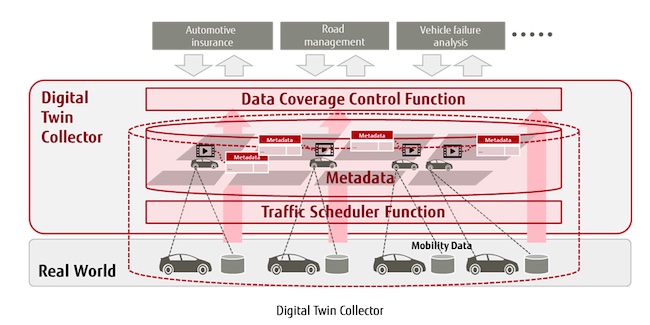Fujitsu launches a new integrated virtual platform for the mobility space, which allows users to seamlessly integrate and manage information on devices including connected cars, smartphones, and tablets. Fujitsu will offer the new platform, the “Fujitsu Future Mobility Accelerator Digital Twin Collector,” to automobile manufacturers and insurance companies in the Japanese market from April 22, with availability to follow in North America and Europe from June 2021, contributing to the realization of new mobility services on a global scale.
As a wide-area distributed data access technology optimized for mobility, the Digital Twin Collector delivers stable communications by regulating the volume of data sent from the mobility device to the cloud with the Traffic Scheduler Function, while the Data Coverage Control Function enables comprehensive data collection without duplication. These functions make it possible to reproduce and process large volumes of data from mobility devices on the cloud platform as needed, significantly reducing costs for the management and transmission of large amounts of vehicle and traffic data.
With the development of this platform, Fujitsu demonstrates its ongoing contributions to the realization of automated driving systems, including the creation of high-precision maps used by automobile manufacturers, etc., as well as offering detailed data on driving conditions including congestion, obstacles, and weather to vehicles on the road by road management companies.
Background
In recent years, the
world has faced growing demand for innovative solutions to the
challenges posed by exponential increases in data generated by connected
vehicles and the digital transformation of transportation through new
mobility technologies. To address this, Fujitsu has developed and
launched its stream data processing platform, “Digital Twin Utilizer,”
as well as an in-vehicle camera image analysis platform, “Digital Twin
Analyzer.”
The introduction of Fujitsu’s new “Digital Twin
Collector”, which greatly reduces the cost of data collection and
storage by virtually integrating and managing the data held by mobility
devices, represents the latest development in this ongoing effort to
streamline the use of big data with digital twin technology.
Digital Twin Collector Overview
1. Distributed management of data held by mobility devices reduces data collection and storage costs
The
platform virtually integrates distributed data by managing only
lightweight metadata (1), rather than storing large amounts of data such
as video recorded by mobility devices in the cloud. This allows users,
including car manufacturers and insurance companies, to access only the
data they need, significantly reducing the amount of data and traffic in
the cloud, delivering cost savings of 50% (2).
2. Traffic Scheduler Function provides stable data access by regulating congestion of large-volume data communications.
When
it is necessary to collect video data simultaneously from one’s own
vehicle and surrounding vehicles due to an accident, etc., the burden on
the cloud side increases rapidly and congestion occurs as data is
accessed and copied from each device. This may disrupt the flow of data
or reduce data accessibility. The new Traffic Scheduler Function
regulates bulk traffic by controlling data replication requests from
mobility devices. This provides stable data access.
3. Data
Coverage Control Function delivers consistent service quality by keeping
data duplication under control and performing comprehensive replication
Biases
introduced at the time training data is collected for self-driving
systems may impact service quality. The Data Coverage Control function
performs a cross-sectional analysis of the data access and acquisition
status for a large number of mobility devices, thereby contributing both
to the prevention of duplication of similar data, such as video data
with the same time, location, and viewing angle, and the completeness of
the acquired data. This helps to ensure service quality for the data
being used for analysis as well as the service itself.
Use Case
– Improving the efficiency and sophistication of insurance operations
When
an accident is detected, simply by specifying the location and time of
the accident, a video from before and after the accident can be
automatically obtained for the vehicle and surrounding vehicles. This
allows insurance companies to provide automotive insurance service that
handles accidents in a way that takes into account multiple
perspectives.
– Upgrading road management services
Based on
vehicle behavior, the system can capture images in real time related to
traffic congestion, accidents, falling obstacles, bad weather, and other
events occurring on the road, enabling the road management company to
provide detailed traffic control services in a timely manner.
– Vehicle failure analysis
By
collecting peripheral images when abnormal values are detected by
vehicle sensors, automobile manufacturers can use them to estimate the
cause of failure and provide feedback for vehicle development.
Service Overview
In addition to the basic service that virtually integrates and manages data distributed on mobility devices, Fujitsu will offer several types of services, including a requirement definition support service that organizes requirements according to customer needs, setup service that creates usage environments, support service and customization service at individual quotation basis.


